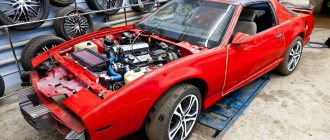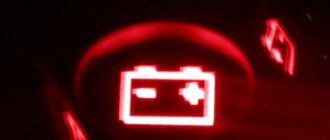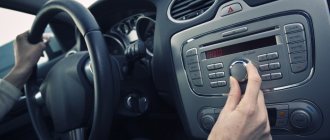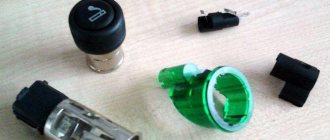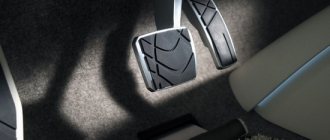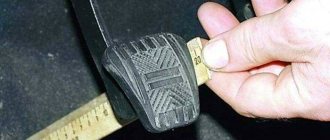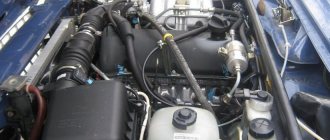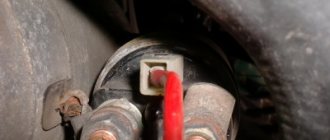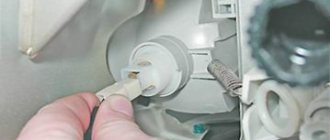If when you turn the ignition key you only hear a loud crash from the engine compartment, do not rush to immediately blame the starter for all your troubles. There may be several reasons for this phenomenon, and a breakdown of the starter retractor relay is just one of the most common malfunctions. Today we will talk about why the starter began to crack and what to do to restore its functionality.
Why the starter cracks: finding and eliminating the cause
If when you turn the ignition key you only hear a loud crash from the engine compartment, do not rush to immediately blame the starter for all your troubles. There may be several reasons for this phenomenon, and a breakdown of the starter retractor relay is just one of the most common malfunctions. Today we will talk about why the starter began to crack and what to do to restore its functionality.
Main symptoms of malfunctions
So, what to do in such a situation, and where to look for the problem, if you got behind the wheel of a car and turned the key in the ignition, but this did not give the desired result. The reasons may lie in the battery itself, or malfunctions of the starter, or in various connections and switching. Most often, of course, the culprit is the battery itself. It may simply discharge, and the following signs will indicate this:
Causes of malfunction
Before we begin to study the causes of the malfunction, we remind you that hereinafter we are talking about the crackling noise of the starter, which is most similar to the loud rattling of the contacts of an electromagnetic relay. If you hear an unpleasant metallic grinding noise from under the hood, then it appears due to poor engagement of the overrunning clutch (starter Bendix) with the flywheel teeth - that’s a completely different story.
Most often, the starter crackles when you turn the ignition key for three reasons:
Low battery
To understand the cause of the crackling noise due to a discharged battery, let's remember the starter device. When you turn the ignition key, the voltage from the on-board network is supplied to the coil of its solenoid relay. The electromagnetic forces that appear in this case cause the armature of the device to move. It closes the power contacts that connect the starter motor to the battery, and in addition, causes the Bendix gear to engage with the flywheel.
When the battery is discharged, its energy may be enough to attract the metal core - cranking the crankshaft is out of the question. As soon as the starter contacts close and power is supplied to its electric motor, the voltage drops to such an extent that the electromagnet is unable to hold the metal core. Under the action of the return spring, it tends to take its original position and opens the power contacts. The restored voltage contributes to the repeated retraction of the anchor, and the situation is recreated many times.
To make sure that the culprit of the problem is a deep discharge of the battery, just turn on several consumers (lighting, electric heater motor, etc.) and press the sound signal. The latter will either not turn on at all, or will be heard with wheezing, reduced amplitude or attenuation.
Poor engine ground contact
The picture of what is happening is practically indistinguishable from the case discussed above, with the only difference that the test for battery discharge ends with a negative result - all consumers, including the sound signal, are working at full strength.
At the same time, it is very simple to determine that the cause of the malfunction is poor contact between the battery and the engine - just pay attention to the oil pressure warning lamp, which is located on the instrument panel. If the voltage in the car’s on-board network is below normal, then turning the ignition switch to the “Start” position will lead to a gradual attenuation of the brightness of the warning lamp (like all others).
In the case where the cause of the crackling sound of the starter solenoid relay is a bad ground, an attempt to start the engine will lead to its complete extinction in time with the clicks of the solenoid relay. At the same time, other indicators practically do not change the intensity of the glow.
Everything is explained very simply - the “mass” of the oil pressure sensor, as well as the starter, is the housing. Therefore, as soon as the electrical contact between the engine and the battery is lost, both of these devices stop working synchronously.
Open or shorted starter relay winding
Another reason why the solenoid relay cracks is an interturn short circuit or a break in its holding winding. In other words, the efforts of the electromagnet become insufficient to keep the power contacts of the starter relay in the closed state and engage the overrunning clutch gear with the flywheel ring gear. Under the action of the return spring, the bendix tends to take its original position, and the contact pad located on the armature opens the electrical connection. After this, the retractor winding turns on again and the situation repeats itself many times, which causes the crackling noise.
to determine that in this case the starter solenoid relay has failed by the behavior of the warning lamps located on the instrument panel. At the moment when the loud clicks of the starter are heard, their brightness does not change - the switching of the starter motor occurs for such a short time that the battery voltage practically does not drop.
Something else useful for you:
IF THE STARTER CLICKS BUT DOES NOT CRANK. HOW TO FIND THE PROBLEM YOURSELF
To find out why the starter clicks but does not turn, it is necessary to disassemble its structure and switching circuit, including the components on which its operation depends.
Let's divide the entire structure that interests us into three elements: the power system - for the starter, this is, first of all, the battery; switching – all connections (wires and relays); the starter itself. OPTION ONE – Battery
This is perhaps one of the most common types of malfunctions of this kind. Its essence lies simply in a discharged or inoperative battery. It is easy to determine if the battery is discharged: if the solenoid relay clicks, but the starter does not turn, and the lights on the dashboard go out, the culprit is the battery; when a series of clicks occurs, and the lamps also noticeably dim, then, as in the previous case, the battery is to blame; if nothing happens at all, then the battery may also be discharged - you need to check it with other loads (for example, turn on the headlights). If the cause is the battery, then it would seem that everything is simple - just charge it (or light it) and you can hit the road. But not everything is so simple, because the unclear reason that caused the consequence in the form of an unsuccessful launch will cause the same consequence again. Therefore, it is worth figuring out why the battery was discharged.
Battery discharge. Why?
Everything is elementary if a light was simply left on somewhere, or another consumer was left on. But if everything was turned off, then it is necessary to check the quality of the generator, as well as the serviceability of the battery itself.
SWITCHING
Switching the starter is simple - the plus of the battery is screwed to the solenoid relay, the minus is on the housing, and for starting, a small cross-section wire from a typical relay, which is controlled by the ignition switch, is suitable.
RELAY
If, when you turn on the ignition, the relay clicks, but the starter does not turn (and the solenoid relay also does not work), then the reason may be in the relay itself or the control cable. You can accurately install it in a fairly simple way - you need to apply “+” power to the starter control terminal (where the cable of the smallest cross-section is connected, shown with an arrow in the photo). how to check the relay and wiring If the starter starts to “turn”, then the reason is in the wiring, relay or ignition switch. Note. Before checking, you must make sure that the car's gearbox is in neutral, otherwise the car may start moving. By the way, if the trip is urgent, then you can start the engine this way. You just need to turn on the ignition and manually (by applying positive power to the control terminal) start the engine.
BAD CONTACTS
If the starter clicks but does not turn and, at the same time, extraneous sounds occur (as an option, it sometimes clicks, sometimes it does not click) - you need to check all connections, especially the power cable. The point here is that when starting the engine, the starter consumes quite a lot from the battery - about 200 amperes. If the contact is insufficient somewhere, then out of the required 200 it can “get” only 10, which is enough for the solenoid relay to operate, but not enough to start. In the same case, a series of “clicks” may occur. It is necessary to check all connections (including battery terminals), clean the contact pads from oxides, lubricate them with special lubricant and tighten to the recommended torque.
MALFUNCTIONS OF THE STARTER ITSELF
Typically, this type of malfunction cannot be eliminated without dismantling the unit.
But it is possible, relatively accurately, to find out the reason. Let's consider the electrical part of the starter, which includes: windings; brush assembly; solenoid relay. Let's consider them in descending order of probability of failure. RETRACTING RELAY
So, if the starter clicks once, but does not turn, you should check the retractor relay.
To do this, you can try to run the starter bypassing its switching. There are three terminals on the solenoid relay - two of them are the largest (one is the input from the battery, the second is the output to the starter itself) and one is small, the control one. You will need a suitable tool - a screwdriver or a wrench, which can securely close two large terminals (arrow in the photo) for a short period of time, and it is necessary that the selected tool does not touch the body (any metal parts under the hood). how to check the solenoid relay If, when the terminals are closed, the starter begins to rotate (possibly with a bang), then the solenoid relay is to blame. Note
:
You should not start the engine this way, because... The starter drive gear does not engage. The point here is that inside the relay, the contact pads were simply “burnt”, and a dielectric layer of metal oxides formed on them. Given the high operating current, the contacts can “burn out” in one start attempt. There are two solutions
- you can disassemble the relay and clean the contacts, or replace it. The second option is much better, because such repairs will last longer. This is due to the fact that in production the contact pads are covered with a special layer of an alloy of non-ferrous metals (with the inclusion of “noble”), which reduces electrical erosion and the likelihood of oxidation. Having cleaned them, this layer will be missing, so such a relay will not work for a long time.
BRUSH UNIT
If it comes to checking the brushes, then you cannot do without dismantling and disassembling the starter. It is during disassembly that the wear of the brushes will be immediately visible. This can be indirectly determined by a long period of operation, because The resource of the brush assembly is quite large. It is worth noting that in some design options, if the brushes are faulty, the retractor relay may also not operate. Those. If the retractor doesn’t “click” and the starter doesn’t go straight, then the brushes may well be to blame.
WINDINGS
Failure of the windings can give away their color and smell. Naturally, this will become visible when disassembling the starter, and, in many cases, it will be easier and more reliable (and sometimes cheaper) to replace it entirely. In general, the symptoms are similar to a malfunction of the brush assembly.
Source
How to fix a rattling starter
The method for troubleshooting depends on what is causing the problem. If the starter cannot work normally due to a discharged battery, it is enough to charge it to the required parameters. Typically, charging is carried out with a current of 0.1C, where C is the battery capacity in ampere-hours. At the same time, highly discharged current sources and calcium batteries should be charged with low currents (1-2 A) to at least 25% charge (this parameter is controlled by the density of the electrolyte). The gentle mode will take more time, but will protect the battery from many negative aspects.
Note! Often, when the battery is discharged, car owners try to start the engine “from a tow”. Note that this method is only suitable for the simplest power units, but not for injection engines. Launching the latter “from the pusher” often leads to a failure of the electronic control unit software.
In this case, the ECU begins to behave unpredictably - for example, request permission to start from a disabled immobilizer. The situation can only be corrected by reflashing the “brains”, and this, as you yourself understand, is an additional and completely unjustified expense.
In the case where the cracking of the solenoid relay occurs due to poor contact with the vehicle ground, it is enough to simply restore the electrical connection. To avoid problems in the future, it is recommended to remove the tire that connects the engine to the body and clean the contact pads with sandpaper. A thin layer of technical Vaseline or VD-40 universal lubricant will help prevent their oxidation.
If the source of the malfunction is the retaining winding of the starter solenoid relay, then try to repair it. If this is not possible, then a decision is made to replace the solenoid relay assembly. As you can see, even a novice driver can cope with finding the fault that is causing the starter to crack.
Video: Why the starter cracks. Useful advice from an auto electrician.
Source
Characteristics of the malfunction
The starter spins at idle, the teeth slip, which should ensure unidirectional engagement of the shafts when one rotates at a higher speed, and also ensure their separation as soon as the rotation of the electric motor is stopped (this is when, as soon as the car engine starts, the driver releases the key).
Only a radical solution to the problem. Just change it. Fortunately, not all, but only Bendix.
In fact, modern technologies used to manufacture both the starter and one of its main functional units, the bendix, do not imply the possibility (in the event of a malfunction) of the unit to be disassembled and repaired. We'll have to change it. Moreover, fortunately, it is not the entire assembly that has to be replaced, but the bendix, the engagement of which has worn off so much that it is already slipping, does not reach the required power level.
On the other hand, the strength loads of modern automotive parts are designed to have approximately the same service life. That is, even if it is possible, say, to replace the Bendix return or tension spring and thereby eliminate the malfunction, such a unit will still not last very long. Surely, either the balls that ensure the bendix rings roll will soon fall out, or the connection with the shaft will slip, losing the engagement mechanism.
So, with such a characteristic malfunction as a lack of engagement with the engine, when the torque slips without connecting, there can only be one verdict - change it. Moreover, the procedure is simple, and the part itself is not particularly expensive. You can cope with the replacement, at least on a domestic car, yourself, or by contacting the nearest car service center.
What else is worth reading
Clutch slips Starter device Service life of glow plugs Ignition switch circuit Starting the engine with a button
The starter makes a crunching noise when you start it
- To the beginning of the forum
- Forum Rules
- Old design
- FAQ
- Search
- Users
I'm wondering what it could be. 21124, 1.6 16cl. mileage 51 thousand km.
When starting (and the colder the machine, the more noticeable) a grinding noise (or even a crunching sound) is heard. The sound is similar... well, as if something is rotating without lubrication.. As long as the key is in the “starter” position, there is no grinding noise, the engine begins to seize (“ I turn off the starter) and while the engine is spinning up immediately after starting and picking up speed, this grinding noise appears. lasts 1-2 seconds.. and disappears.. when the glitch is “hot” it is less noticeable.. or not at all or shorter term..
I suspect the starter. it's like I'm turning it off too late
— a kind of twisting of an engine that has already been started.. but how to check that it is he? and what in him can manifest itself this way? (although it starts fine)
It also feels like the rotation of a dry bearing of some kind... and then with scrolling - the lubricant disperses and the grinding noise goes away. But this is most likely not the case - after all, for example, when restarting immediately after the previous one, there is also a grinding noise...
In general, if anyone has encountered something similar or has any other ideas, please let me know, I’ll be grateful
